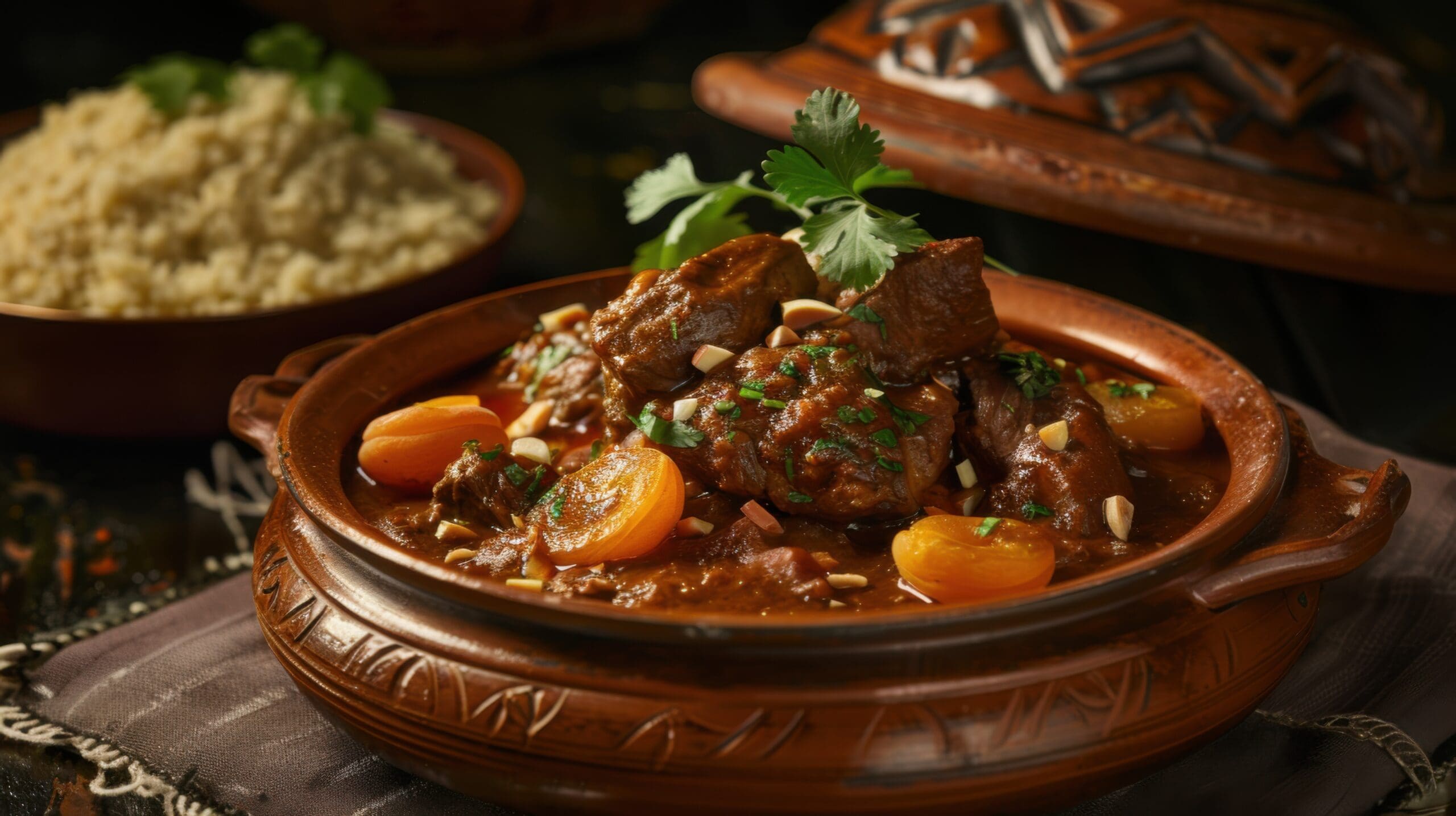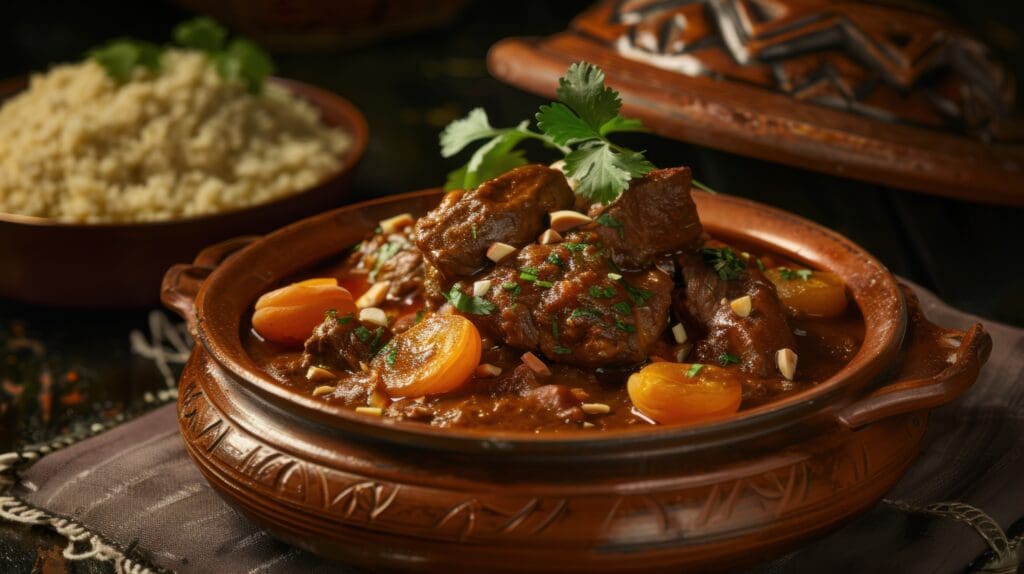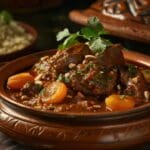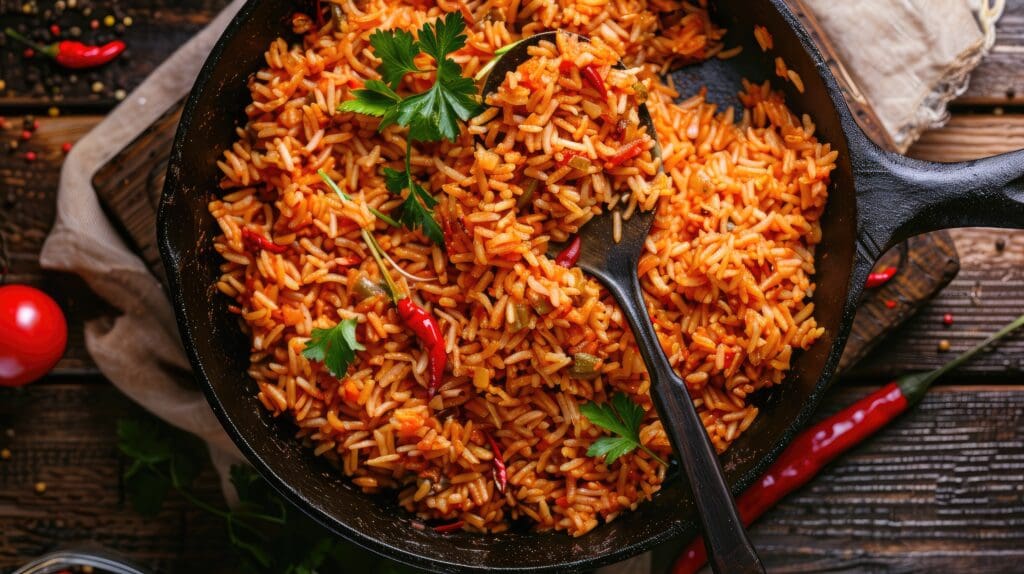

The Moroccan Lamb Tagine is a traditional North African dish that brings a wonderful mix of flavours and aromas into your home. This classic recipe showcases succulent lamb paired with the natural sweetness of apricots and the hearty texture of chickpeas. With an assortment of vibrant spices and fresh herbs, every bite of this dish is a burst of flavours.
Introduction to Moroccan Lamb Tagine
A significant part of Moroccan cuisine, tagines are named after the earthenware pot in which they are cooked. The unique design of the tagine pot, with its conical lid, allows steam to circulate and ensures that the meat remains tender and juicy. However, even without this special pot, the Moroccan Lamb Tagine can still be made with impressive results using a Dutch oven or slow cooker.
The origins of the Moroccan Lamb Tagine date back centuries, with influences from Berber, Arab, and Andalusian cultures. It’s a dish that not only tastes good but also tells a story of a rich culinary heritage. The combination of sweet and savoury ingredients, along with aromatic spices, exemplifies the essence of Moroccan cooking.
This dish is ideal for both special occasions and everyday meals, offering a hearty and satisfying option that is both nutritious and flavourful. The lamb, cooked slowly to absorb the spices and sweetness from the apricots, results in a dish that is rich in taste and deeply comforting. Preparing a Moroccan Lamb Tagine at home is more than just cooking; it’s an experience that brings the vibrant and colourful world of Moroccan cuisine into your kitchen.
Here is the recipe:

Moroccan Lamb Tagine with Apricots, Chickpeas, Vegetables, Spices, and Fresh Herbs
Ingredients
- 800 g lamb shoulder, cut into chunks
- 2 tbsp olive oil
- 1 large onion, finely chopped
- 3 cloves garlic, minced
- 2 tsp ground cumin
- 2 tsp ground coriander
- 1 tsp ground cinnamon
- 1 ground ginger
- 1/2 tsp ground turmeric
- 1/2 tsp cayenne pepper (optional)
- Salt and freshly ground black pepper, to taste
- 400 g chopped tomatoes
- 500 ml chicken or vegetable stock
- 200 g dried apricots, halved
- 400 g can chickpeas, drained and rinsed
- 2 large carrots, sliced
- 1 red bell pepper, chopped
- 1 courgette, sliced
- 1 small aubergine, chopped
- 1 tbsp honey
- A handful of fresh coriander, chopped
- handful of fresh mint, chopped
- Cooked couscous or bread, to serve
Instructions
Prepare the Lamb
- Season the lamb chunks with salt and pepper. Heat 1 tablespoon of olive oil in a large, heavy-based pan or tagine over medium-high heat. Brown the lamb in batches, ensuring it's well-sealed on all sides. Remove the lamb and set aside
Cook the Vegetables
- In the same pan, reduce the heat to medium and add the remaining olive oil. Add the chopped onion and garlic, cooking until softened and golden, about 5 minutes.
Spice It Up
- Stir in the ground cumin, coriander, cinnamon, ginger, turmeric, and cayenne pepper, if using. Cook for 1 minute until the spices release their fragrance.
Simmer the Tagine
- Return the lamb to the pan, along with the chopped tomatoes and stock. Bring to a gentle simmer, cover, and cook for 45 minutes
Add Sweetness and Vegetables
- Stir in the apricots, chickpeas, carrots, red pepper, courgette, aubergine, lemon zest, and honey. Continue to simmer, covered, for another 30-40 minutes until the lamb and vegetables are tender.
Finish with Herbs
- Just before serving, stir in the fresh coriander and mint. Taste and adjust seasoning as needed.
Serve
- Serve the lamb tagine hot with couscous or bread, allowing everyone to enjoy the rich, aromatic flavours.
Notes
Slow Cooker
For the slow cooker method, follow the initial steps of searing the lamb and sautéing the vegetables on the hob. Then transfer everything, including the apricots, chickpeas, and stock, into the slow cooker. Set it on low and let it cook for six to eight hours. This method is especially convenient for busy days, as it requires minimal supervision while delivering a richly flavoured dish.Oven
If you prefer using the oven, preheat it to a low temperature, around 150°C (300°F). After browning the lamb and softening the vegetables on the hob, transfer them to an oven-safe pot. Add the apricots, chickpeas, and stock, then cover with a lid and place it in the oven for approximately two hours. This method mimics the slow-cooking environment of a tagine pot, ensuring the dish remains succulent and aromatic.Ingredients
The magic of Moroccan Lamb Tagine lies in its carefully selected ingredients. At the heart of the dish is the lamb, ideally bone-in pieces like shoulder or shank for added flavour. The apricots introduce a subtle sweetness that complements the rich meat, while chickpeas add texture and protein. A medley of vegetables such as onions, carrots, and courgettes enhance the dish’s nutritional profile and provide a balance of flavours. However, it is the spices that enhance the tagine: cumin, coriander, cinnamon, and ginger combine to create a warm and aromatic base. Fresh herbs like coriander and parsley finish the dish with a burst of colour and freshness.Nutrition
Suggestions for Serving
To enhance the enjoyment of your Moroccan Lamb Tagine, serve it with a side of fluffy couscous, which perfectly absorbs the aromatic sauce. Alternatively, a warm, crusty bread is an excellent choice to mop up every last bit of the delicious juices. A fresh green salad with a citrus vinaigrette can provide a refreshing contrast, balancing the richness of the tagine. Roasted vegetables, such as aubergines or bell peppers, can also make a colourful and nutritious addition to the meal. For a more authentic experience, consider serving the tagine directly from the pot, encouraging a communal style of dining where everyone can help themselves. Garnishing with fresh coriander or parsley not only adds a burst of colour but also enhances the dish’s fresh flavours. A sprinkle of toasted almonds or sesame seeds can introduce a delightful crunch, adding texture to the dish. For those who enjoy a bit of spice, a side of harissa paste can offer an extra kick. Complement the meal with a Moroccan mint tea, which aids digestion and provides a soothing end to the feast.
Conclusion
The Moroccan Lamb Tagine with apricots and chickpeas presents a harmonious blend of savoury and sweet, enhanced by a rich array of spices. This dish embodies the essence of Moroccan cuisine, making it an exceptional addition to any meal plan. The slow-cooking process ensures that the lamb is tender and infused with the vibrant flavours of the apricots, chickpeas, and spices. Whether prepared in a traditional tagine pot, a Dutch oven, or a slow cooker, the result is consistently flavourful and satisfying. This recipe offers not only a delicious meal but also a way to explore the culinary traditions of Morocco in your own kitchen. Preparing a Moroccan Lamb Tagine can be a delightful experience.


